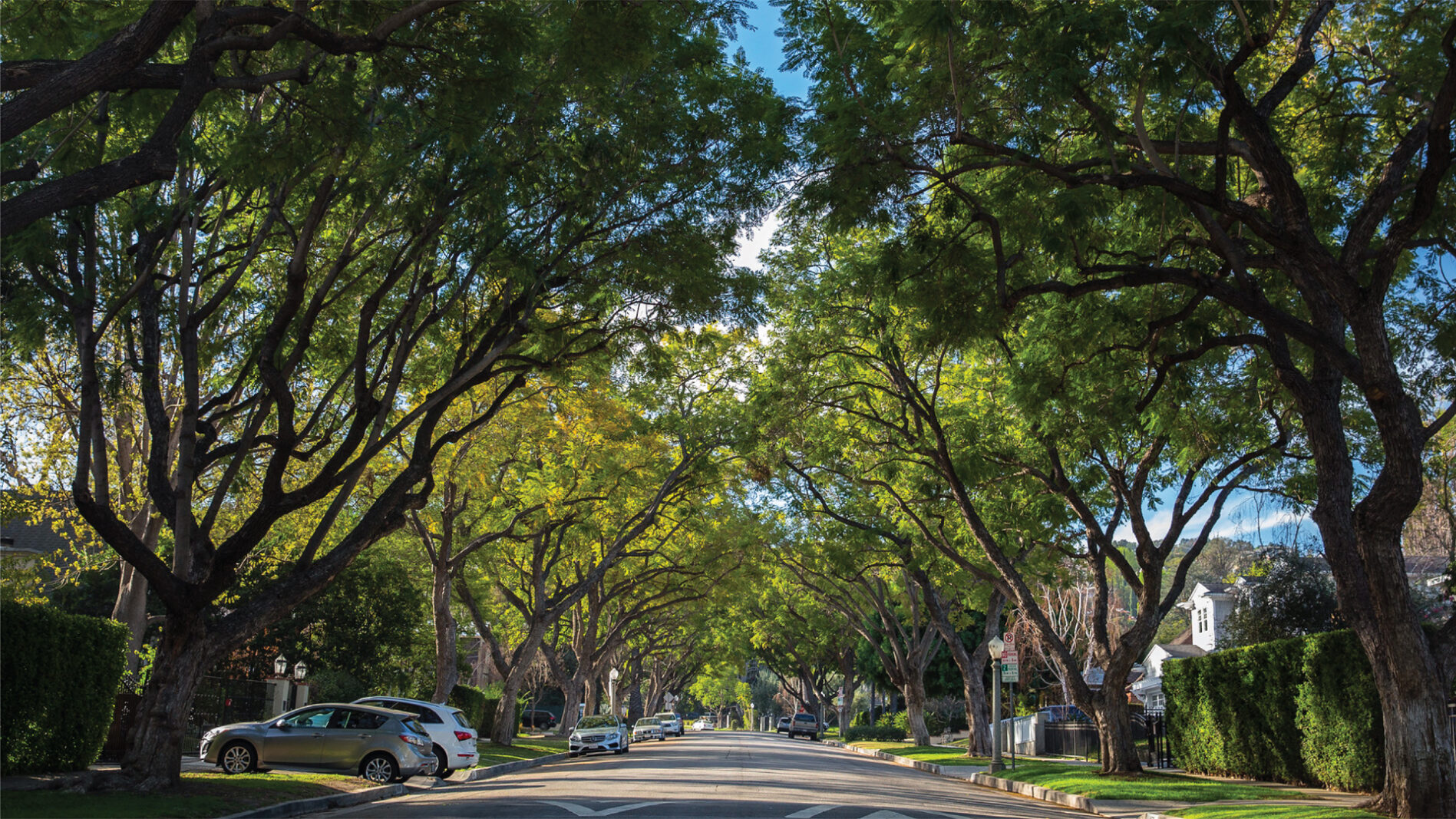Learn more about why we need to plant and care for trees:
Excess carbon dioxide (CO2) is building up in our atmosphere, contributing to climate change. Trees absorb CO2, removing and storing the carbon while releasing oxygen back into the air. In one year, an acre of mature trees absorbs the same amount of CO2 produced when you drive your car 26,000 miles.
Trees absorb odors and pollutant gases (nitrogen oxides, ammonia, sulfur dioxide and ozone) and filter particulates out of the air by trapping them on their leaves and bark.
In one year an acre of mature trees can provide enough oxygen for 18 people.
Average temperatures in Los Angeles have risen 6°F in the last 50 years as tree coverage has declined and the number of heat-absorbing roads and buildings has increased. Trees cool the city by up to 10°F, by shading our homes and streets, breaking up urban “heat islands” and releasing water vapor into the air through their leaves.
Three trees placed strategically around a single-family home can cut summer air conditioning needs by up to 50 percent. By reducing the energy demand for cooling our houses, we reduce carbon dioxide and other pollution emissions from power plants.
Shade from trees slows water evaporation from thirsty lawns. Most newly planted trees need only fifteen gallons of water a week. As trees transpire, they increase atmospheric moisture.
Trees reduce runoff by breaking rainfall thus allowing the water to flow down the trunk and into the earth below the tree. This prevents stormwater from carrying pollutants to the ocean. When mulched, trees act like a sponge that filters this water naturally and uses it to recharge groundwater supplies.
On hillsides or stream slopes, trees slow runoff and hold soil in place.
Skin cancer is the most common form of cancer in the United States. Trees reduce UV-B exposure by about 50 percent, thus providing protection to children on school campuses and playgrounds - where children spend hours outdoors.
An apple tree can yield up to 15-20 bushels of fruit per year and can be planted on the tiniest urban lot. Aside from fruit for humans, trees provide food for birds and wildlife.
Studies have shown that patients with views of trees out their windows heal faster and with less complications. Children with ADHD show fewer symptoms when they have access to nature. Exposure to trees and nature aids concentration by reducing mental fatigue.
Neighborhoods and homes that are barren have shown to have a greater incidence of violence in and out of the home than their greener counterparts. Trees and landscaping help to reduce the level of fear.
Trees cut down on noise pollution by providing a buffer from cars, machinery, and other people.
Fruit harvested from community orchards can be sold, thus providing income. Small business opportunities in green waste management and landscaping arise when cities value mulching and its water-saving qualities. Vocational training for youth interested in green jobs is also a great way to develop economic opportunities from trees.
Whether as houses for children or creative and spiritual inspiration for adults, trees have provided the space for human retreat throughout the ages.
Tree plantings provide an opportunity for community involvement and empowerment that improves the quality of life in our neighborhoods. All cultures, ages, and genders have an important role to play at a tree planting or tree care event.
Healthy soils are critical to the establishment of trees. Utilizing structured soils within the urban planning process allows for adequate root growth support for soil and tree health.
Sycamore and oak are among the many urban species that provide excellent urban homes for birds, bees, possums and squirrels.
Trees can mask concrete walls or parking lots, and unsightly views. They muffle sound from nearby streets and freeways, and create an eye-soothing canopy of green. Trees absorb dust and wind and reduce glare.
A tree’s root system is responsible for nutrient and water absorption, utilizing roots as sensors to detect water-deficit conditions and send signals to shoots above ground. Drought-tolerant native species have water-seeking roots that penetrate deep into the soil to tap into local groundwater to draw to the surface.
Urban tree canopies are a nature-based approach to ever-worsening floods. Tree canopies increase the surface area where stormwater falls, decreasing the amount of runoff from reaching the ground. Root systems serve as water catchment areas that promote infiltration.
Studies show that the more trees and landscaping a city has, the more people are likely to engage with public infrastructure and local businesses. This increases the use of alternative transportation such as bicycling and public transit, further helping to reduce a city’s carbon footprint, and brings customers to local shops and merchants.
Trees are cost-effective solutions to combat the adverse effects of climate change, such as extreme heat, droughts, and floods. Trees are the only piece of infrastructure that gains value over time!

